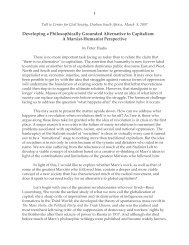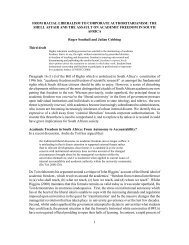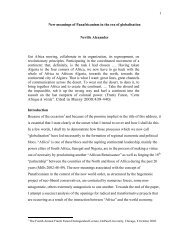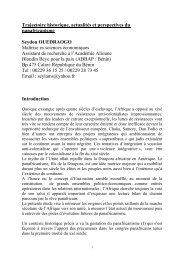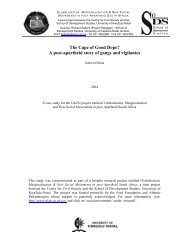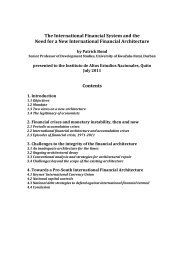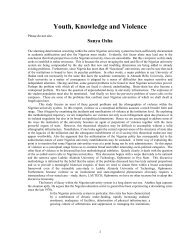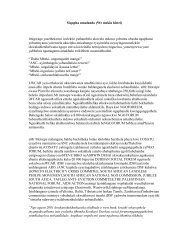April 2011 - Centre for Civil Society - University of KwaZulu-Natal
April 2011 - Centre for Civil Society - University of KwaZulu-Natal
April 2011 - Centre for Civil Society - University of KwaZulu-Natal
You also want an ePaper? Increase the reach of your titles
YUMPU automatically turns print PDFs into web optimized ePapers that Google loves.
evolution from Tunisia spread through mainstream media rising from the<br />
networks <strong>of</strong> social media to the mainstream. In this in<strong>for</strong>mation warfare,<br />
the news outlet Al Jazeera acted as a source <strong>of</strong> in<strong>for</strong>mation connecting the<br />
struggles throughout the world <strong>of</strong> dictators and despots.<br />
INTENTIONALITY, SELF-ORGANISATION, SELF-MOBILISATION AND SELF-<br />
EMPOWERMENT<br />
When the second stage <strong>of</strong> the revolution was maturing, the interim<br />
government closed schools and universities in an attempt to blunt the<br />
youth energy. After the universities reopened, there were new<br />
demonstrations across Tunisia as teachers and students called a general<br />
strike. The full expression <strong>of</strong> a worker–student alliance was beginning to<br />
take shape as workers occupied workplaces while setting up committees to<br />
run their workplaces. It is this advanced consciousness <strong>of</strong> worker control<br />
that is slowly taking shape as the revolution <strong>of</strong> Tunisia experiment with<br />
networks <strong>of</strong> networks beyond the old standards <strong>of</strong> democratic centralism<br />
and other worn ideas <strong>of</strong> revolutionary organisation and the vanguard party.<br />
Social media and social networking may represent one <strong>of</strong> the <strong>for</strong>ms <strong>of</strong> this<br />
revolutionary process, but the character is still embedded in the sel<strong>for</strong>ganisation<br />
and self-emancipation <strong>of</strong> the oppressed. It is this powerful<br />
<strong>for</strong>ce <strong>of</strong> self-emancipation that is acting as an inspiration and beating back<br />
vanguardists, whether secular or religious.<br />
In order to discredit this revolutionary process, the Western media has<br />
been running the bogey that Islamists would be the beneficiaries <strong>of</strong> the<br />
revolution. But the women <strong>of</strong> Tunisia have demonstrated clearly that they<br />
are not going to be sidelined in a revolutionary process. These women,<br />
inside and outside <strong>of</strong> Tunisia, have been organising <strong>for</strong> decades and will<br />
not be silenced in this moment <strong>of</strong> revolution. What was visible from the<br />
images in Tunisia was the centrality <strong>of</strong> women and youths in this<br />
revolutionary process. Women in Tunisia had been organising <strong>for</strong> decades<br />
against patriarchy and other <strong>for</strong>ms <strong>of</strong> male domination. It was one <strong>of</strong> the<br />
societies where the women had stood firm against the fundamentalists<br />
who wanted to control the bodies and minds <strong>of</strong> women. These women<br />
made common cause with the youths and other sections <strong>of</strong> the working<br />
people to <strong>for</strong>m the backbone <strong>of</strong> the revolution. Their presence and<br />
firmness acted as a barrier to the kind <strong>of</strong> vanguardism that could be<br />
claimed by sections <strong>of</strong> the opposition. Hence as Ben Ali fled, all <strong>of</strong> the<br />
socialists, communists, Islamists, trade unionists, human rights workers,<br />
rappers and other social <strong>for</strong>ces emerged on the political stage <strong>of</strong> Tunisia.<br />
The placards and slogans that proclaimed ‘vive la révolution’ were a<br />
manifestation that all over the country, from south to north, there had<br />
been a burning desire <strong>for</strong> change.<br />
This burning desire <strong>for</strong> change was most clearly expressed in the<br />
expressions <strong>of</strong> workers and poor farmers from the rural areas, who<br />
converged on Tunis as they chanted: ‘We have come to bring down the rest<br />
<strong>of</strong> the dictatorship.’ They did this in defiance <strong>of</strong> a curfew and state <strong>of</strong><br />
emergency. They had travelled through the night in a caravan <strong>of</strong> cars,<br />
trucks and motorcycles from towns across the rocky region far from<br />
Tunisia's luxurious tourist beaches.<br />
I was in West Africa as this revolution unfolded. Everywhere I went, youths<br />
and other workers were anxiously following the revolution as the mass<br />
resistance spread to Algeria, Egypt, Jordan and Yemen. In all <strong>of</strong> the<br />
societies I visited there were young people who wanted to know more<br />
about what was happening in revolution. Bouazizi’s action sends a major<br />
lesson to youths across Africa and the pan-African world. This lesson is<br />
embedded in the significance <strong>of</strong> his self-immolation. Bouazizi’s selfimmolation<br />
signifies self-sacrifice, different from the actions <strong>of</strong> suicide



